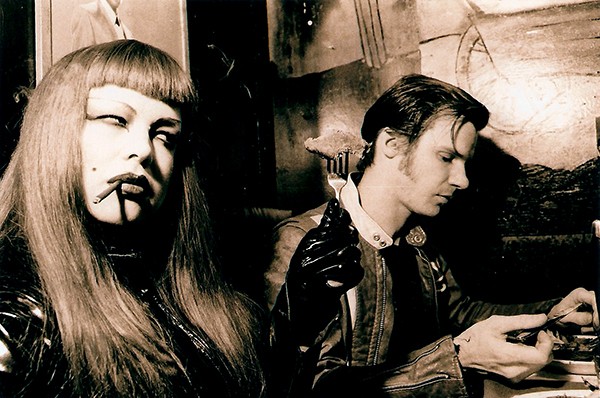It is said that, in a sense, all movies are documentaries of the time of their creation. “We were living at the end of the 20th century, the American century, the rock-and-roll century,” says director J. Michael McCarthy. “What were we doing about it? The Sore Losers, even though I had never intended to make any money on it, became more of an homage to the idea of having fun with some people who agreed to do some crazy things on camera.”
McCarthy had been in the middle of the Memphis punk and garage scenes since his band Distemper played the first all-ages show at the Antenna club in 1986. In the mid-’90s, the MCA grad had a feature film under his belt about growing up punk in Mississippi. His next film would be bigger, stranger, and much more ambitious: a sci-fi, horror, burlesque, comic book fantasia about rockabilly S&M aliens who come to Earth to murder exactly 13 hippies.

Kerine Elkins as Hermaphrodite and Jack Oblivian as Blackie in The Sore Losers.
The director populated his cast with glamorous weirdos from the burgeoning garage-rock scene centered around The Oblivians. Jack Oblivian, who had once told McCarthy he wanted to be in a porno, became Blackie, the homicidal alien greaser in danger of being exiled on Earth forever because he killed too many flower children. Californian Kerine Elkins, who plays leather-bound alien psychopath Hermaphrodite, got McCarthy’s number from a flyer in an ally behind Hollywood Book and Poster and ended up with a starring role. Texan D’Lana Tunnel had starred in McCarthy’s Teenage Tupelo. “Jack gave her one of my business cards. She called me from Sun Studios the next day. She sounded like Betty Boop over the phone. I asked her if she would like to play my mother in a film. She said sure. Then I asked if she would have a problem with nudity.”
Guitar Wolf flew in from Japan “to drive into the deepest, darkest forests of Mississippi, where the blues was born, and spend four days making this movie out of nothing more than a handshake. That continues to amaze me.”
It was as punk behind the scenes as it was in front of the camera. They stole beer from the set of The People vs. Larry Flynt and descended on Tupelo like glam-rock aliens. McCarthy says his motto was “Don’t ask permission, shoot until they make you stop, then deny everything … We had every form of security guard, policeman, sheriff, and other law enforcement messing with us during the entire shoot in Mississippi and in Memphis … You should make a movie just to find out what you can accomplish through promises, manipulation, coercion, and, yes, payment if necessary.”
The film plays like a ’50s teenage exploitation flick designed with a comic artist’s keen visual composition. “The 1990s were a big garage sale of the 20th century,” says McCarthy. “You could throw anything into the mix and come out of it with some style.”
The Sore Losers became a cult hit for McCarthy. “The movie has screened all around the world. It’s gotten me to Europe and back a couple of times.”
The version that has existed all these years was pieced together through a chaotic editing process, and very little sound design. For its 21st anniversary, producer Nan Goldin and McCarthy remastered the film. Gilbert Halpern scanned 10,000 feet of film, getting color and nuance from cinematographer Darin Ipema’s 16 MM photography, while sound designer Sean Faust has created a 5.1 mix. The restored version will open and close this year’s Gonerfest, on Wednesday, September 26th and Sunday, September 30th at Studio on the Square. A new vinyl release of the kicking rock soundtrack is available at Goner Records, with a Blu-Ray to arrive later this winter.
The Sore Losers stands as a unique document of a lost Memphis. Many of the locations, like the Western Steakhouse, which was Elvis’ favorite restaurant, and the Pyramid Club, (which stood about where third base in Redbirds Stadium is now), punk dive Barrister’s, and the old main library on Peabody, are long gone. “Memphis was the original scene in the 1950s that sent this wave out and made London the scene in the ’60s and New York the scene in the ’70s. I thought this scene we had in the ’90s was an indication of that ripple coming home at the end of the 20th century. We were just a bunch of nobodies with no money, but we create the best music and the best culture, and we have the best friendships. We can create this artwork. That’s exactly what the ’50s were about in Memphis. And that’s what I’m most proud of with The Sore Losers.”